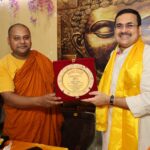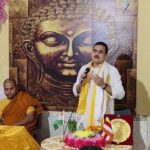A TRIBUTE TO CULTURAL RECONSTRUCTION
- By : Anirban Ganguly
- Category : Articles
The so-called intellectual mainstream relegated SP Mookerjee to an ideological corner and suppressed his versatility, his national acceptance and his vision for national progress
Sixty one years after he was consigned to a confined and lonely death by free India’s first democratically elected Government on June 23, 1953, Syama Prasad Mookerjee’s dream and vision of creating an alternate political stream and narrative in India has finally achieved fruition. The question as to why a personality of his stature and dimension, who had nothing but India’s supreme national interest in mind and who strove to establish the democratic experiment in India on a firm footing, met with such an end is one of those lingering and unexplained episodes in India’s history which still await their moment of truth. Ironically, this unraveling of the truth was suppressed simply because the self-professed democrats of that era, belonging to a particular ideological hue, all Mookerjee’s contemporaries and colleagues in national politics, displayed a staunch aversion to unraveling the truth behind his death in detention.
Mookerjee’s evaluation in the field of politics has somewhat been done, but even here the so-called intellectual ‘mainstream’ relegated him to an ideological corner and suppressed his versatility, his national acceptance and his encompassing vision for national progress. Rarely was there a leader who displayed such dexterity in varied fields such as education, culture, politics, parliamentary affairs and administration. Generations today would perhaps scarcely believe that in each of these fields Mookerjee attained the pinnacle and that too in such a short and action packed life.
Leaving his politics aside here, it is indeed fascinating to see the civilisational vision that Mookerjee exuded. As president of the Mahabodhi Society of India, he had long anticipated the need to revive India’s civilisational ties in her neighbourhood. Long before the ‘Look East Policy’ had been conceived, Mookerjee looked to South-East Asia and as the carrier of Buddha’s message sought to bind the region in a civilisation knot with its mother country, India. In his reminiscence, Dr Syama Prasad Mookerjee in Indo-China, JM Majumdar, for example, describes how the then Cambodian monarch, Norodom Sihanouk, welcomed Mookerjee and the Relics of Buddha’s chief disciples as an “immense ‘Kusala’ for our country and people to have henceforth a direct bond with Lord Buddha owing to the arrival of the sacred relics.” In reply Mookerjee spoke of how despite passing through “varying fortunes, good and bad”, the “ancient land of Cambodia and many other adjoining countries still bear the indestructible signs of the heritage that have come from our Motherland, Bharat, since time immemorial.”
But his action was not limited to these exchanges alone, one of the legends in the study of Indian art, Stella Kramrisch, in her assessment of Dr. S.P. Mookerjee and Indian Art, mentioned how he worked indefatigably to establish the study of Indian history and culture in the University of Calcutta and set up one of the earliest museums of Indian art and supported some of the best scholars of the epoch to carry out research on India’s past. As Kramrisch noted, “art mattered to him and he in turn left his mark not on the history, but on the future of art in India.” The deeper objective of Mookerjee’s cultural activism, however, was to bring about a larger cultural reconstruction in India, as he spelt it out once in one of his presidential addresses to the Asiatic Society, “Let me emphasise that I do not at all minimise the need for a radical reorientation of the economic and industrial policy of India. A country whose educational and economic backwardness is a standing disgrace to human civilisation has got to be placed on her feet again and its people must get fullest advantage of its inexhaustible raw materials. But let me state at the same time that neither can India attain her full strength and glory nor can she contribute worthily to the cause of stabilising human civilisation, if we ignore the need for a proper cultural reconstruction in India.”
The eventual working out of that ‘cultural reconstruction in India’ would perhaps be another lasting tribute to Mookerjee and to his fascinating life and legacy.

















